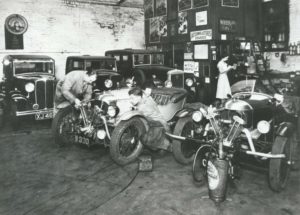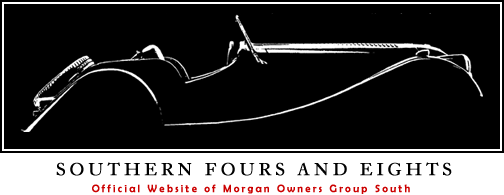Morgan Dealers Raising The Profile (www.mogmag.co.uk)

Today, glossy, hi-tech car dealerships are an everyday part of the car purchase process, but back in the day, when Harry Morgan was promoting his Runabout, dealers who could interface with customers on behalf of the factory were few and far between. MMC Archivist Martyn Webb traces the history of the early Morgan dealers and the key part they played in the success of the business.
Harry Morgan was a naturally gifted engineer and an intuitive, instinctive innovator. He also had the ability to analyse and adapt the ideas of others and to combine these features with his own designs to create machines that were clearly ahead of those of his competitors. The Morgan Runabout proved itself to be strong, reliable and very competitive when pushed to the limit on the race track or the trials hills. Enthusiasts were effusive in their praise for the machine and the motoring press declared that this was the most competent of all Cyclecars. Additional exposure at the Olympia Motorcycle show and other exhibitions raised Morgan’s profile still further and the factory could scarcely keep pace with the extraordinary demand for their cars.
“WHEN HARRY MORGAN WAS PROMOTING HIS RUNABOUT, DEALERS WHO COULD INTERFACE WITH CUSTOMERS ON BEHALF OF THE FACTORY WERE FEW AND FAR BETWEEN”
To fully exploit Morgan’s success, however, the factory needed representatives around the country to promote the Runabout to those potential customers who would not normally have read the motoring press or come into contact with these devices. Having secured a sale, the factory then required agents to collect and distribute the machines and subsequently maintain them and effect occasional repairs, most owners being unfamiliar with motor vehicles at that time.
The first-known Morgan dealer was Jack Sylvester who approached Harry Morgan at the 1911 Olympia Motorcycle Show intent on securing an agency. Despite being assured by Morgan that he “didn’t intend to make many”, Sylvester persisted and although there was never any written contract, he took on the agency for Bennetts of Nottingham and was certainly selling Morgans by the end of 1911 and continued through to his retirement

Sylvester’s Garage
Morgan’s assertion that he didn’t intend to make many was soon proved wrong since having launched the first two- seater at the show, the machine proved a huge success and he struggled to meet the demand.
Morgan’s next association was therefore rather forced upon him, not only to gain the maximum exposure for the Runabout, but to help distribute and even to assist with the building of the machine. During the show, Morgan had negotiated a new contract with Richard Burbidge of Harrods, making the Knightsbridge store officially the sole concessionary of the Runabout (presumably overlooking the verbal agreement with Sylvester). From now on Harrods would deal with all enquiries addressed not only to themselves, but also to the Morgan factory. For their part, Harrods placed an immediate order for 50 machines and paid a deposit of around £500, a sum that would at least help to finance the expansion of the works. Details of this arrangement were set out in letters between Harry Morgan and Richard Burbidge that survive in the Morgan Motor Company archives. Towards the end of 1911 Harrods introduced their own bodywork for the Morgan, allowing the Malvern factory to concentrate on the chassis alone.
Despite the existence of clear documentary evidence of the contract with Harrods, it would seem that Morgan continued to look elsewhere for other dealers, the next being pioneer motorist Billie James of Sheffield.

James of Sheffield
It was clear at this time that the arrangement with Harrods, whilst selling lots of cars, was not ideal. The Harrods body was rather too elaborate and being heavier than the simple bodies that the Morgan factory fitted, adversely affected the car’s performance. Chasing business through other channels, Harry Morgan defaulted on his commitment to Harrods and fell behind with orders, much to the displeasure of Burbidge! The sole concessionary agreement with the store was thus abandoned and although Harrods continued to sell the occasional Runabout alongside machines from other manufacturers, they were never listed by the factory as official dealers. Harry therefore continued to expand his network of dealers in major towns and cities around the UK.
By 1914 there were no fewer than 45 dealers, with four in London (not including Harrods) and foreign dealers in Switzerland (R. Voltz, Auto-Garages, oune) and in France (L. Baudelocque & R, Darmont, 128, Rue de Bois, Levallois). Darmont in Paris would eventually develop the business to build Morgans under license in France to cope with the considerable demand from the Continent. Such was the rapid increase in demand for motor vehicles following the First World War, that by the early ’20s the factory was at maximum output, whilst building new workshops to increase production further and the dealer network had grown to 78 representatives around the UK alone!
“HARRODS PLACED AN IMMEDIATE ORDER FOR 50 MACHINES AND PAID A DEPOSIT OF AROUND £500, A SUM THAT WOULD AT LEAST HELP TO FINANCE THE EXPANSION OF THE WORKS”
The Morgan Motor Company was now the largest cyclecar manufacturer in the UK, producing thousands of cars per year. Racing and trials successes ensured that Morgans were the most sought-after machine for the sportsman as well as those requiring more mundane transport.
By the late 1920s there were nearly 90 official Morgan dealers, plus many independent garages that regularly carried stock of used machines.
Some Morgan dealers, well-known to enthusiasts today can trace their roots back to this period. F.H. Douglass of Ealing, affectionately known as “Douggies” and still in business until a few years ago, was established in the mid-1920s, as was Lifes Motors, currently the oldest Morgan dealer in the world and still selling cars today.
“RACING AND TRIALS SUCCESSES ENSURED THAT MORGANS WERE THE MOST SOUGHT-AFTER MACHINE FOR THE SPORTSMAN”
Demand for the Morgan three-wheeler declined throughout the early 1930s as motorists became more demanding and knowledgeable about vehicles. The introduction of conventional small four-wheeled cars in the 1920s, such as the Austin Seven, effectively ended the fashion for cyclecars and whilst the Morgan trike survived, the factory had little option but to supplement this with the first four-wheeler: the Morgan 4/4.
Most dealers embraced the new machine with enthusiasm and the dealer network ensured the success of the 4/4. Some, however, such as E.P. “Joe” Huxham in Bournemouth remained true to the original machine. Appointed by the factory as a dealer in 1932, Joe Huxham was a larger-than-life character, famous for his “rallies”. These were fun, competitive events, which became more famous for the sessions in the pub after the day’s events, rather than the motoring activities!!
Closer to home, even Malvern Link had its own dealer. A local garage Bowman & Acock looked after sales of Morgan cars in the town, as well as after-sales servicing, a mere quarter of a mile from the factory. Established in 1935, Bowman & Acock bought the original Worcester Road factory when the last workshop (the machine shop) finally moved to Pickersleigh Road.
There is little doubt that the extensive network of dealers established by Harry Morgan in the early years was fundamental to the success of the business. They promoted, sold, distributed, serviced and repaired the cars as well as spreading camaraderie and enthusiasm for these idiosyncratic vehicles. The same is as true today as it was a century ago, and the Morgan Motor Company continues to enjoy the support of UK and overseas dealers to bring the pleasures of Morgan motoring to enthusiasts around the world.
“THE EXTENSIVE NETWORK OF DEALERS WAS FUNDAMENTAL TO THE SUCCESS OF THE BUSINESS”

I own a 1960 Morgan +4 4str Chassis No 4576 sold by F H Douglass on the 29th August 1960.It has had 16 owners in New Zealand since arriving here in 1961 and at some stage the F H Douglass name plate was removed from the dashboard.I would appreciate if someone may know if any of these still exist from this former business.
Kevin York
Keven, I haven’t a clue who might have access to replicas of the FH Douglass name plate. I suspect you will have to have one made custom if you can find a sample somewhere.
Cheers,
Mark (Florida)